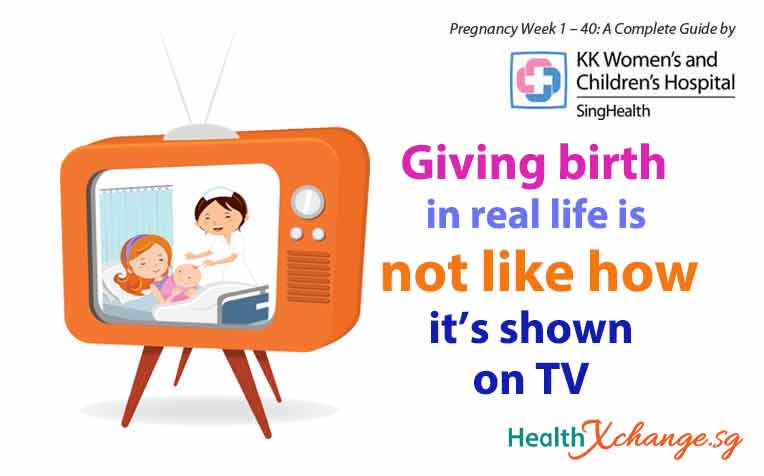
Pregnancy week 34 : Unlike childbirth on TV which is overly dramatised and quick, real-life childbirth requires going through three stages of labour.
For mom
Giving birth: TV vs real life
"Pushing" and giving birth has been over dramatised in television (TV) dramas and movies. It's not as quick a process as what you see on TV: In real life, women don't always get rushed to the hospital the minute they feel contractions and emerge with a baby straight after. Here's a stage by stage account of what to expect.
3 Stages of labour
There are 3 stages of labour - your cervix dilating, the actual delivery of the baby and expelling the placenta.
First stage of labour
The first bit takes the longest time, especially if it’s your first pregnancy. If you have had children before, you will find this a much smoother process.
In the first stage of labour, you will be experiencing strong contractions and yet during this time, you will need 4-hourly vaginal checks to see how dilated your cervix is. These vaginal checks become more frequent later on. They can be quite uncomfortable but are part of an inevitable process. After you reach 4cm dilation, things speed up and you dilate about 1cm/hour. It can then be said that you are in active labour.
That's 6 hours to go before you are fully-dilated at 10cm (Definitely not sounding like those TV dramas now!). However, that time frame is just a guide. Even expert obstetricians are occasionally surprised at how fast some mothers progress. In other words, no one timing fits all.
Second stage of labour
Your body reacts to full dilation by helping you feel the urge to "bear down". It's the same sensation you get when you feel like doing a poo. Now, you actually have to "push". It's quite a contained environment in the room. Screaming wastes energy that could be otherwise channelled towards the actual push. Long pushes help the baby pass through the birth canal effectively. Otherwise, your baby may keep slipping back upwards and take longer to emerge and this can become taxing on both yourself and baby.
Third stage of labour
Your baby's out, the cord's half out but the placenta isn't. No one notices, but you get a jab in your thigh. It is an injection of oxytocin to help your uterus contract and push the placenta out. By now, you're all sweaty and very tired and will need all the help you can get.
You've huffed and puffed, pushed and pushed, and finally lie backwards, hearing the first cry of your newborn child. Congratulations in advance, this will be you in no time. It isn't always that glorified, there is often a lot of cleaning up to do and sometimes you may sustain a tear or require a cut (episiotomy) during the delivery process. These can be repaired via dissolvable stitches.
For baby
While you've been contracting and dilating, your baby was been working hard too. It's been progressively moving downwards, closer to the birth canal.
As the baby descends, your backache tends to get worse and midwives would be trying to help you find a suitable birthing position.
It's a good thing your baby's skull bones do not fuse at this age. Their movement will facilitate your baby's exit as it adopts a variety of positions on the way out.
What it feels like for baby to come into the world
For your baby, coming into a whole new world is a shock to its system and it needs to adapt quickly. Tiny little air sacs in its lungs are filling up with air as it takes its first breath of life. The bright lights and commotion throw it into confusion. Soon it will take its first cry.
As dad cuts the umbilical cord, changes to its blood flow are also occurring. The natural hole in its heart closes up as the heart pumps blood around in the same way as us adults. Your newborn will be covered with blood, fluid, and a creamy-coloured coating which protected it while it was in your womb. After months of waiting and anticipation, this magical being has finally appeared!
Ref: L20
Click the link for the complete listing of articles for Pregnancy Week 1 - Week 40.
Contributed by















 Get it on Google Play
Get it on Google Play